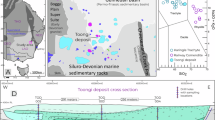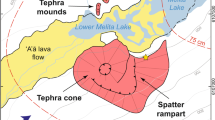Abstract
Pyroxene fractionation trends in igneous rocks depend on the magma composition and the conditions of crystallization. Four main types of pyroxene crystallization trend have been recognized in terrestrial igneous rocks (Fig. 1). These are the clinopyroxene trend of mildly alkaline basic magmas1,2; the clinopyroxene trend of strongly alkaline basic magmas3; the two-pyroxene trend typical of tholeiitic magmas4–6; and the two-pyroxene trend typical of calc-alkaline intrusions7–9. The calc-alkaline pyroxene trends show restricted iron-enrichment as high causes the crystallization of calcic amphibole (and biotite) in place of pyroxenes at a fairly early stage of fractionation. Ca-rich and Ca-poor pyroxenes from the Fongen–Hyllingen complex which coexist with hydrous mafic phases and initially have compositions very similar to those from calc-alkaline complexes, show extreme iron-enrichment in the late differentiates. This is the first recorded example of such extreme pyroxene fractionation in elevated conditions and this fractionation trend, accompanied by other distinct mineralogical features, warrants designation as a new type: the Fongen–Hyllingen trend.
This is a preview of subscription content, access via your institution
Access options
Subscribe to this journal
Receive 51 print issues and online access
$199.00 per year
only $3.90 per issue
Buy this article
- Purchase on SpringerLink
- Instant access to full article PDF
Prices may be subject to local taxes which are calculated during checkout
Similar content being viewed by others
References
Gibb, F. G. F. J. Petrol. 14, 203 (1973).
Aoki, K. Am. Miner. 49, 1199 (1964).
Nash, W. P. & Wilkinson, J. F. G. Contr. Miner. Petrol. 25, 241 (1970).
Brown, G. M. Miner. Mag. 31, 511 (1957).
Brown, G. M. & Vincent, E. A. J. Petrol. 4, 175 (1963).
Atkins, F. B. J. Petrol. 10, 222 (1969).
Best, M. G. J. Petrol. 4, 223 (1963).
Best, M. G. & Mercy, E. L. P. Am. Miner. 52, 436 (1967).
Nockolds, S. R. J. geol. Soc. Lond. 96, 451 (1941).
Wilson, J. R. & Olesen, N. Ø. Norsk geol. Tidsskr. 55, 423 (1975).
Olesen, N. Ø., Hansen, E. S., Kristensen, L. H. & Thyrsted, T. Leid. geol. Meded. 49, 259 (1973).
Esbensen, K. H., Thy, P. & Wilson, J. R. Norsk geol. Tidsskr. 58, 103 (1978).
Nwe, Y. Y. Contr. Miner. Petrol. 55, 105 (1976).
Cawthorn, R. G. Am. Miner. 61, 907 (1976).
Author information
Authors and Affiliations
Rights and permissions
About this article
Cite this article
Wilson, J., Esbensen, K. & Thy, P. A new pyroxene fractionation trend from a layered basic intrusion. Nature 290, 325–326 (1981). https://doi.org/10.1038/290325a0
Received:
Accepted:
Issue date:
DOI: https://doi.org/10.1038/290325a0
This article is cited by
-
Petrogenesis of ultramafic and mafic xenoliths from Mesozoic basanites in southern Sweden: constraints from mineral chemistry
International Journal of Earth Sciences (2007)
-
Cumulate chemistry and its bearing on the origin of layering: Evidence from the Fongen-Hyllingen basic complex, Norway
TMPM Tschermaks Mineralogische und Petrographische Mitteilungen (1983)
-
Discordant layering relations in the Fongen–Hyllingen basic intrusion
Nature (1982)
-
Extreme differentiation in the proterozoic Gjerstad-Morkeheia Complex of South Norway
Contributions to Mineralogy and Petrology (1982)



